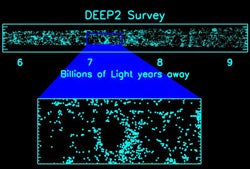University of Chicago astrophysicists have determined there is a simple way to model cosmic-structure evolution that matches observations.
When simulating large-scale structure formation, scientists usually use dark-matter models because there is far more dark matter than ordinary matter in the universe. To compare the simulations with observations, however, scientists must relate luminous matter to dark matter (because we can’t see dark matter).
Many groups use complicated models to relate the two, but the Chicago group — Charlie Conroy, Andrey Kravtsov, and Risa Wechsler — found a simple way to connect the observable properties of galaxies, such as luminosity, to the properties of dark-matter clumps (called halos) in their simulations. This allowed them to compare clustering of halos to the observed clustering of galaxies as a function of galaxy luminosity. Their findings imply that the distribution of dark matter alone can explain the cosmic web of filaments, superclusters, and clusters of galaxies. More complicated processes are not needed. The fact that their model is successful implies that a galaxy’s luminosity is intricately related to the mass of its host dark-matter halo.
The Chicago group was able to use this method because of some of the highest resolution numerical simulations ever run. Their method lets them track cosmic evolution at both the small and large scales simultaneously. At small scales, they can model dark-matter distribution surrounding galaxies while tracking the clustering evolution of the objects on large scales.
DEEP2 observed cosmic structure between redshifts z=0.7 and z=1.3 (which centers on z=1, when the universe was half its present age). This gives the “most precise measurements of the clustering of galaxies at z=1 ever performed,” Conroy, a member of the computational and DEEP2 group, told Astronomy. The DEEP2 team found that brighter galaxies are more clustered, meaning they reside in more massive dark-matter halos.
These observations, combined with data from the Sloan Digital Sky Survey (which has observed structure at a redshift of roughly z=0.1), agree with the Chicago team’s computer simulations and simple relation between galaxy luminosity and halo mass. The computational model they used, says Conroy, is “appealing because it has so few assumptions and inputs, and yet agrees so well with observations over most of the age of the universe.”
Both the computational findings and the DEEP2 observations (with lead author Alison Coil of the University of Arizona) will appear in the June 20, 2006, issue of The Astrophysical Journal.











